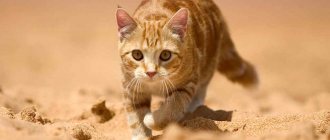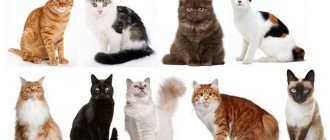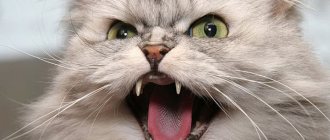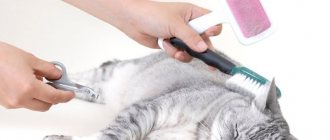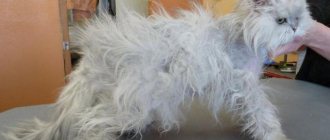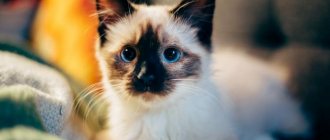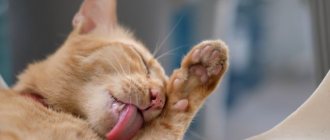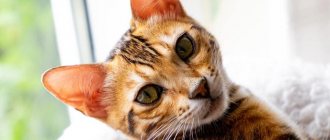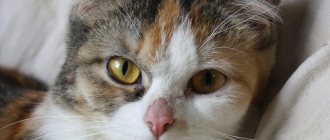The great variety of cat colors is determined by just two pigments: black (eumelanin) and red (pheomelanin). Coat color is the end point in the formation, movement and development of the cells (melanocytes) that produce these pigments. And the entire rich palette of colors appeared thanks to mutations that provoke deviations at different stages of this rather complex process.
Only one mutation poses some danger to the life of the animal, when melanocytes freeze in development at an early stage, and the hair is not painted. White coat color is not a color, but its absence. In addition, the cat becomes deaf, since the mutant gene affects the development of the hearing system. A white cat with two blue eyes is often deaf in both ears.
Color changes occur throughout the cat's life and do not cause the animal any problems. Depending on environmental conditions, the color of the coat may also change: in most cases this will not harm the cat’s health.
Shedding in cats
Cats' fur is very important for maintaining their vital functions. Fluffy and smooth-haired domestic cats have a common coat structure. It differs in structure, structure and role from human hair. Each hair has a certain lifespan, but in addition to the natural replacement of hairs, there is also a process of almost complete change of coat - shedding. When getting a pet, you need to know how shedding occurs, why it is necessary, and how to deal with thick patches of fur covering furniture, carpets, curtains and parquet.
How to find out if a kitten will be fluffy
How to determine by appearance whether a kitten will be fluffy (long-haired) or smooth-haired (short-haired) when it grows up? If you buy from breeders, they will definitely answer this question 100%, since a certain breed without impurities was specially bred with all the necessary characteristics that the breeders know about, including the length of the coat.
The gene for long hair is recessive, that is, if the mother cat and father cat are both fluffy, then the kitten will be fluffy, and if one of the parents has short fur, then the kittens can be fluffy or not in a ratio of 50%/ 50%.
In cases where a kitten was found on the street and no one knows its pedigree, how can one find out what kind of fur it will have when it grows up? There are several popular methods for determining the approximate degree of fluffiness of a future adult cat at a very young age. These methods can determine whether a kitten will have long or medium-length fur as an adult.
Wool texture and type
According to scientists, animal fur is similar in origin to the spines of a hedgehog or the quills of a porcupine. A cat's coat consists of two types of hair:
- Guard or integumentary hairs are stiffer, longer hairs that provide a protective function; Down or undercoat are short, curled hairs that create a thermal insulating layer.
Both types of wool differ in structure and function. The outer hair is tougher due to the fact that it has a core inside, consisting of a core and cortex. The top of the hair is covered with a cuticle - a layer of cells with scales. The structure of the cortex determines the strength and elasticity of the hair.
Pigment grains are located in the core and cortex. The hair cells above the epidermis layer are dead. The looser arrangement of the inner layers of cells requires protection, which is provided by the outer layer - the cuticle. Tile-shaped translucent cuticle scales protect hair from physical and chemical influences.
Depending on the density of the scales, the coat has a silky shine or dullness. Most cats have straight guard hairs, and only some breeds - Selkirk Rex, Devon Rex, Cornish Rex, Skookum, Laperm - have curly hair. This happens because they lack guard hairs of the first order, and the thinner outer hairs of the second and third orders undergo crimping.
Cover hairs are divided according to thickness and length into hairs of the 1st, 2nd, 3rd and even 4th order. The furs of the first order are the thickest and longest. There are not many of them in a cat's fur coat. They protrude above the surface of the cover. The quality and smoothness of the fur coat depends on their quantity. In cats, each hair of the first order is surrounded by 2-5 primary or lateral hairs. Each primary hair is in turn surrounded by secondary downy hairs.
Downy hair is thinner and has a discontinuous or missing core. They have tortuosity, which forms a layer of downy air between the surface of the body and the external environment. The follicles in the thickness of the skin are located obliquely, so the coarse guard hair covers and protects the more delicate and hygroscopic down hair.
In cats with a “wild” coat structure, hairs of different orders form tufts that are collected in groups. The hair follicles of the guard and down hairs are laid in the thickness of the epidermis at different times, which is why a kitten’s coat differs in structure from the mature coat of adult cats.
The length of the integumentary hairs determines what type of coat the cat is:
- long-haired - outer coat longer than 5 cm (Persian, Siberian, Maine Coon, Kurilian Bobtail, Neva Masquerade, Norwegian Forest, Somali, Burmese); short-haired - with short (less than 5 cm) top coat tightly adjacent to the body (Abyssinian, Asherah, Bengal, Bombay, Savannah, Snow Shoe, Toyger).
A special gene is responsible for the length of the coat. In cats of the same breed, the length of the coat may vary depending on climatic conditions.
Cats have hair density that is 5 times higher than that of humans and 3 times higher than that of dogs.
Age-related changes
Another inevitable reason why a cat's fur color has changed is age. And not only very old age, but also 5 years and even 3 years. The color usually darkens with age.
The multi-colored patterned colors gradually blur and turn into mush. The matter is complicated by ticking - coloring each hair with several transverse rings of light and dark tones. It should be noted that the patterned color cannot appear without ticking: these characteristics are genetically related.
Functions of the coat
Different hairs on cats have different functions. Topcoat hair covers the undercoat and skin. The sebaceous glands approach their base. Their secret prevents the wool from getting wet. In some breeds, the wool has a very high water-repellent effect, in others this ability is lower.
Downy hair forms a thermoregulating layer - it prevents the body from cooling down and overheating. The underpad also protects the surface of the skin from cracking, drying out, and damage. Wild cats, forced to wade through bushes for prey, have a denser undercoat. Through it, thorns and twigs cannot reach the delicate skin of the animal.
In addition, the pigment in the fur with a “wild” color allows the animal to merge with the surrounding landscape. Anyone who decides to get a pet that does not cause problems with shedding - hairless cats - is faced with the problem of caring for the pet's sensitive and delicate skin.
Hair also includes vibrissae - hard, long hairs located on the pads on the sides of the nose, above the eyes, on the lower jaw, and the back of the paws. Their length varies from 6 to 8-9 cm. Vibrissae are organs of mechanical sensitivity (tactile function).
A cat, having lost its fur coat along with whiskers and sensitive hairs on the body, loses confidence in movement. These hairs help determine the distance to objects, their temperature, atmospheric pressure and maintain the position of the body in space. It’s not for nothing that when a cat falls, it turns over so that it lands on its paws.
E. Filippova’s book “From a Cat’s Point of View” describes a case when a cat that fell into the tar had to be completely shaved. The poor thing was afraid to move actively until a new coat grew. Long sensitive hairs help plan a jump - they determine the speed and direction of air movement.
The hair density varies in different parts of the cat's body. For example, to protect the most delicate and vulnerable part of the cat’s body, nature has created a denser covering. There are more than 200 hairs per 1 mm2 of a cat's belly. There are slightly fewer of them on the back of the animal.
Each hair has its own muscle fibers. With any danger, temperature change, or excitement, the fibers contract and the coat rises. The matted fur of a cat during a fight or attack by an enemy increases the size of the cat's body, which should scare off the enemy. When the ambient temperature drops, the cat fluffs up its coat to increase the air “cushion”, which reduces heat loss.
What to do if the cat continues to grow
There are also opposite cases, the cat continues to grow, despite the fact that it has already crossed all age limits.
In this case it is necessary:
- understand the reasons for this phenomenon;
- put the animal on a diet;
- limit your diet to high-carbohydrate foods;
- encourage the cat to lead an active lifestyle;
- consult a veterinarian.
In order for a pet to grow properly, it is necessary to create favorable conditions for it: feed it with balanced food containing vitamins; maintain a temperature of at least 20 °C; from time to time, give anthelmintic drugs and fight skin parasites. Only then will the pet feel great.
The mechanism of molting and its classification
Depending on the role of hairs in the life of a cat, they participate or not in the molting process. For example, broken, fallen or damaged vibrissae are renewed, but do not participate in the molting process. They are too important for an animal to lose a sensory organ 2-3 times a year.
Natural hair loss is classified into the following types of shedding:
- age (children); seasonal; compensatory.
Kittens have soft, fluffy fur. Even kittens of smooth-haired and some hairless breeds have baby vellus hair.
The first age moult occurs at the age of 5 months and continues until 8-12 months. This is the longest molt.
A change in the structure of the coat is noted visually and tactilely - the fur coat becomes tougher and denser. In kittens with a pattern on their skin, the contrast of the points increases. The light “haze” designed to camouflage the babies disappears, and the color becomes brighter.
Seasonal molting is associated with adaptation to thermoregulation in different seasons of the year. The first molt occurs in the spring. The warm, thick fur falls out, and the coat thins due to the loss of down. The guard hairs also become slightly shorter, especially in long-haired breeds. As a result of molting, their hair falls out in clumps, while short-haired cats lose their hair evenly.
In the fall, repeated molting occurs, and the light summer coat is replaced by a warmer winter coat. As a result of low temperature, processes in the follicles of the pelvis are activated. They “wake up” and the lower layer of fur becomes thicker and denser. The period of natural seasonal molting can last from several weeks to several months. There is more hair loss in the spring than in the autumn.
Compensatory molting occurs in response to damage to the epidermis as a result of chemical or thermal exposure. New wool may differ in structure and even color.
In domestic animals, clear seasonality is blurred. Cats that don't go outside may lose hair all year round. The body does not experience sudden changes in temperature and lighting. This “apartment” shedding occurs more intensely in the cold season, as heating devices dry out the air, which negatively affects the condition of the coat.
In addition to natural shedding, the process of hair loss can be caused by pathogenic factors:
- changes in hormonal levels (endocrine diseases, pregnancy, aging); stress caused by a change of habitat, the appearance of a new pet, the fight for territory, lack of attention; improper care - using inappropriate detergents or combs, bathing too often; unbalanced diet, vitamin deficiency.
The formation of hair follicles occurs in the womb. A hair follicle forms within the thickness of the skin. At its bottom there is a hair papilla. Thanks to the division of its cells, hair forms and grows. The hair root is located inside the follicle and consists of living cells.
Rising above the surface of the skin, the cells lose their intracellular contents, and the core consists of dead keratinized membranes. The rate of hair growth from a cat's fur coat is about 2 mm per week. The speed, strength, elasticity and thickness of the new hair that is formed depends on the cat’s health and proper and regular nutrition.
During molting, the condition of the hair follicles changes. After the hair has fallen out, the germ of a new hair begins to appear inside the bulb. The skin itself also changes. It becomes looser, so you need to comb out the lost hair carefully so as not to injure the epidermis.
Also watch the video on how to deal with shedding in cats:
Ways to Prevent Cat Crying
If the cat is healthy and lives alone in the apartment, then you can prevent cat screams by following the advice of experienced breeders:
- castrate your pet - in the absence of testicles, testosterone is not produced, which means there is no sexual desire;
- breed a cat with a cat;
- give your pet more physical activity;
- not allowing you to sleep during the day - this suppresses the instincts of a nocturnal predator;
- arrange active games with the cat so that he sleeps at night like a baby;
- monitor your pet’s diet - the cat should receive selected foods and meat so as not to feel a deficiency of nutrients. The mustachioed man begins to become lazy, and his hunting instincts become dull.
Some cats are talking breeds and will demand communication. You should not ignore such conversations, and then the animal will be calmer and more satisfied. If the option of obtaining offspring is being considered, then you should get a mate for your pet. A cat and a cat in the same apartment will not let each other get bored and will save the owner from heart-rending screams during the festivities.
If reproduction is not part of the owner’s plans, then you need to think about castration.
Care during shedding period
To speed up the process of fur renewal, it is necessary to remove dead hairs. Brushing every day, especially for long-haired breeds, will help prevent clumps of hair from getting on furniture and carpets.
In addition, combing stimulates blood supply to the hair follicles, which stimulates the growth of new hair. In long-haired cats, regular brushing prevents matting and matting.
You should be careful when choosing a comb or furminator. For example, using a comb with long, sharp teeth to groom a short-haired cat can cause skin injuries and inflammation of minor abrasions.
Some owners believe that frequent bathing will help get rid of loose hair. But frequent use of detergents dries out the skin, weakens hair and increases shedding. If the shedding continues, you should consult a veterinarian; perhaps your pet should be given vitamin and mineral complexes to stimulate hair growth and strengthening.
Cats don't just wait for their owner to do their hair. They lick themselves intensively. Wool accumulates in the intestines. In long-haired breeds, hairballs can cause digestive problems. To make it easier to remove hair from the body, you can give your pet special food, grown “cat” grass or fish oil.
If a person wants to have a cute and affectionate pet, but does not want to collect hair all over the apartment and strain while combing it, then you can always choose a pet among the breeds that do not shed due to the lack of undercoat or hair at all.
How to determine whether a kitten will be fluffy
Signs of long-haired and medium-haired (semi-long-haired) kittens:
- If the hair on the face and near the ears is wavy (curly).
- There is long hair in front of the ears (increased hairiness on the ears).
- The tail is herringbone (it is also compared to a carrot), that is, at the base of the tail the hair is longer and the tail itself is thicker, and towards the end it is shorter (in short-haired kittens the tail is almost even along the entire length) and the tail becomes thinner towards the tip.
- Tufts of fur between the toes.
- The future long-haired kitten is more voluminous and round, and his fur in general is larger, longer and thicker compared to his brothers and sisters or other smooth-haired kittens of his age.
- Dense and thick fur can also indicate that the kitten will grow up fluffy.
Many on the Internet write that it is by the tail (carrot or Christmas tree) that you can tell that a kitten will grow into a fluffy cat or fluffy cat.
Source
Determining age by behavior
How strange: spoiled children, especially strangers, usually cause us irritation; at best, we do our best to restrain ourselves, trying to be tolerant. But looking at the raging kittens, ready to destroy the whole house in their noisy games, a stupid, touching smile stretches even the faces of stern people.
Kitten games are always a delight
One day, an indignant neighbor rang the author’s doorbell, haunted by the constant roar coming from above. Having crossed the threshold, the man looked for several minutes at the three-month-old kittens, selflessly chasing an empty plastic bottle around the floor, then thoughtfully asked: “How much does it cost?” - and went for the money.
Learning to walk
Babies take their first hesitant steps towards the end of the second week of life. At first, it is difficult for them to maintain balance; they sway funny even when sitting, and when they rise to their feet, they have difficulty supporting their plump body on them. Gradually, the forays from the nest become more and more distant, and finally, the bravest one completes the inspection of the entire house.
Between two weeks and a month, babies learn not only to walk, but also to run, jump and climb vertical surfaces using their claws. Having fallen from a height (for example, from a sofa), the baby no longer plops down on the floor with his whole body, but gracefully lands on his paws, deftly turning around in the air.
Hunting is the most important skill for a kitten
By two months, children gradually master hunting skills, their movements and games become more and more “adult”.
From three to six months, the childhood age of small cats is revealed only by excessive activity and immoderate curiosity. By the way, it is during this period that animals often get into trouble, sometimes ending in tragedy.
The author had to endure several terrible hours when his four-month-old cat, having inexplicably slipped through the opened door, decided to explore the new territory and fell into the open hatch of the garbage chute, flying nine floors. Fortunately, the landing was successful: the janitor heard a plaintive meow, and the prodigal daughter was returned to her family.
Learning to eat
As mentioned, WCF strongly recommends that kittens not be separated from their mother until they are three months old. All this time, babies continue to receive mother's milk, but starting from eight weeks, this process is more an element of family communication than nutrition.
They say that kittens need to start switching to solid food at about a month of age, but the author has never had to do this: babies are remarkably “transferred” to adult food on their own when one of them first wanders into the kitchen in search of their mother and discovers her in front of a fragrantly smelling plate.
A month-old fidget will find a bowl of “adult” food on its own
One way or another, kittens begin to feed on their own (lapping and grabbing pieces of food with their teeth) from the ninth week. By this time, as we remember, they have already formed a full row of baby teeth. So, if your baby is pointlessly poking at his plate, he is most likely not yet eight weeks old.
In conclusion, it is worth noting that the speed at which kittens acquire all the above skills largely depends on whether there is an object to imitate nearby. The WCF requirements about the need for kittens to stay in a “full family” for a sufficiently long time are dictated precisely by the fact that for the correct formation of a cat’s character, receiving full maternal education is very important. A puppy can be taught everything necessary by a person, but in cats this function belongs to the mother.
No one can teach a kitten everything necessary for life better than its mother.
This means that if you pick up a helpless baby on the street who can neither walk nor feed himself, perhaps he will learn all this a little later than expected, so when determining the age of your pet, make allowances for his “difficult childhood” .
Video: two-month-old kittens playing next to their calm mother
Often, the age of a kitten is a closely guarded secret (unless, of course, you were personally present at its birth). But by looking closely at your pet, you can break these seals one by one. External signs (weight, size, presence and number of teeth, eye color, ear shape, coat condition, proportions), as well as behavioral characteristics should be used as “keys”. Not all of the mentioned tips have the same degree of reliability and information content, but if you study them together and correctly compare the results, the answer you receive will be very close to the truth.
How to choose a large or small individual in a litter
Choosing a kitten is not the easiest process. If everything is clear about gender, then figuring out what size the future pet will be is not so easy.
It’s easier with purebred individuals, because breeders often tell you what characteristics you should pay attention to
Outbred creatures do not have such clear characteristics. However, examining the mother and baby will help make a decision. A large baby usually has a large head. Its paws are stronger and thicker than those of its smaller counterparts. If you look closely, such a baby eats with great appetite, eating food in excess of the prescribed norm.
Conclusion
It is important for the owner to know what age cats grow up to in order to monitor the development of their pet. The parameters of a pet depend on its heredity, breed, gender
But care cannot be neglected - it also affects the development of the fluffy ball.
The article is of a recommendatory nature. Contact your veterinarian!

